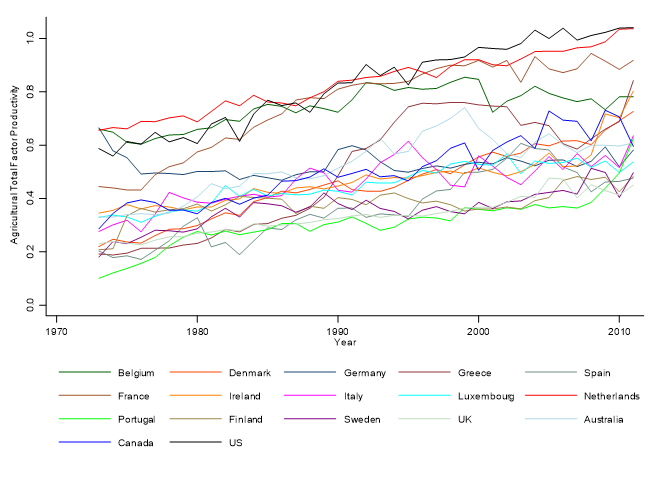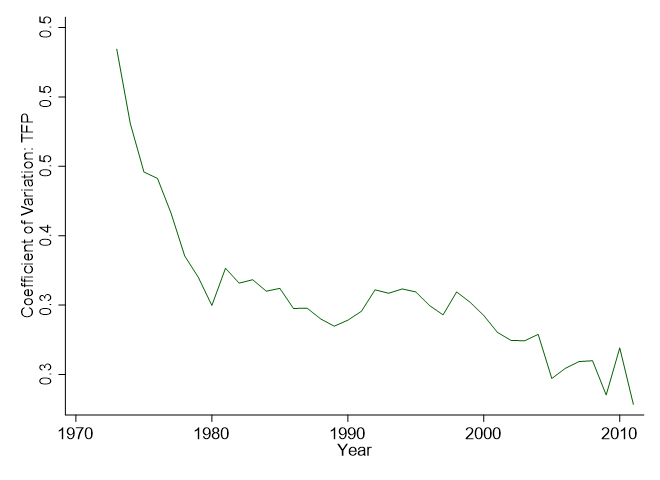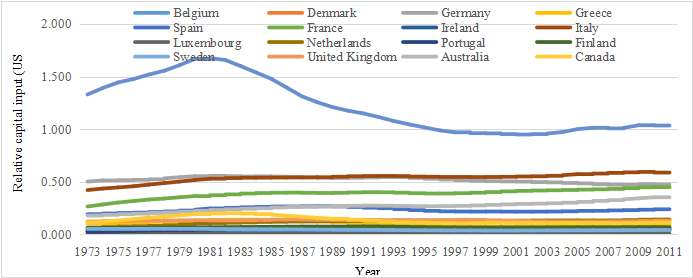Figure 1.Comparing agricultural TFP levels across 17 OECD countries

We measure and compare the relative levels of agricultural TFP for 18 OECD countries over the period 1973-2018. These countries include 14 EU countries (Austria, Belgium, Denmark, Finland, France, Germany, Greece, Ireland, Italy, Luxembourg, the Netherlands, Portugal, Spain, and Sweden) and the United Kingdom, the United States, Canada and Australia.
A slowdown pattern of agricultural TFP growth among the OECD countries for the past two decades
Agricultural TFP in OECD countries has exhibited a relatively high growth rate over the past four decades, contributing to agricultural development throughout the world.
However, recent statistics show that agricultural TFP growth has slowed down in many OECD countries after 2000. Labor shortages, aging populations, climate change, and natural resource depletion could all be potential reasons.
The slowdown agricultural TFP growth stimulated a renewed interest in questions about how to accelerate agricultural TFP growth.
read more
Large disparities remain in the rates of growth across the OECD countries
The remaining large gap in cross-country differences of relative levels of agricultural TFP across the OECD countries has aroused increasing public concerns.
The cross-sectional coefficient of variation of agricultural TFP held constant since the 1980s when globalization was making technological innovation more accessible across these OECD countries.
The remaining large gap in relative agricultural TFP levels in recent years also coincides with slowdowns in growth of agricultural productivity.
read more
Agricultural TFP growth: Technology progress versus Capital Deros
A large number of studies have examined the relative role of capital deepening, compared to technology progress, in affecting agricultural productivity growth, but no consensus has been reached since there are substantial measurement errors.
At the economy level, Baumol (1986), Barro and Sala-i-Martin (1995), Quah (1996, 1997) and Temple (1999) found that capital accumulation will foster the convergence of labor productivity across countries.
But Kumar and Russell (2002), followed by Henderson and Russell (2005) and Badunenko, Henderson and Russell (2010), found that capital deepening can drive non-neutral technological progress and cause international productivity divergence.
Applying the exercise to agriculture, Ball et al. (2001) examined the role of capital deepening in explaining cross-country agricultural productivity growth patterns in the US and 10 EU countries between 1973 and 1993. The results showed that capital deepening facilitated agricultural TFP convergence for the 11 OECD countries before the 1980s, providing support for the embodiment hypothesis (Jorgenson, 1966).
However, they also showed that the role of capital deepening in facilitating agricultural TFP convergence across developed countries disappeared in the 1980s when net investment became negative.
After accounting for quality changes in capital and labor inputs, we show that relative capital intensities for 17 OECD countries and changes in agricultural TFP levels exhibit similar patterns. For example, as most OECD countries have faced increasing farm labor shortages since the 1970s, substitution of capital input for labor input closed the gap in cross-country capital intensities before the 1980s. However, capital intensities grew at a slower rate throughout the 1980s and the 1990s, when high real interest rates choked off new investment causing net obsolesce (Ball et al., 2001; Ball et al., 2010). This trend persisted through the 2000s.
The relationship between convergence of capital intensities and convergence of cross-country agricultural TFP still requires a thorough empirical examination.


